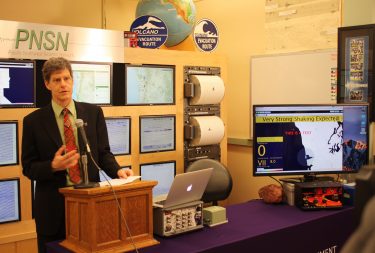
The U.S. Geological Survey and university, public and private partners held an event April 10 at the University of Washington to introduce the ShakeAlert earthquake early warning program as a unified, West Coast-wide system. The event also introduced the first pilot uses of the earthquake early warning in Washington and Oregon.
The first Pacific Northwest pilot users of the system are Bothell, Wash.-based RH2 Engineering, which will use the alerts to secure municipal water and sewer systems so these structures remain usable after a major quake. Oregon’s first test user, the Eugene Water & Electricity Board, will use alerts to lower water levels in a canal above a residential area in Oregon, and to stop turbines at a river power plant. Both utility providers participated in a beta test group that has been learning about the system since early 2015 from the UW-based Pacific Northwest Seismic Network, which coordinates the system in Washington and Oregon.
“We are thrilled to take the first steps in integrating earthquake early warning into life in the Pacific Northwest,” John Vidale, UW professor of Earth and space sciences and director of the Pacific Northwest Seismic Network. “Our teamwork has made it possible to reach this milestone so quickly.”
The ShakeAlert system will provide seconds to minutes of warning before damaging shaking arrives. That would be enough time to get out of a dangerous building, turn off a vehicle, stop surgeries and other delicate activities, and prepare for the imminent ground shaking.
Read more at UW Today »
